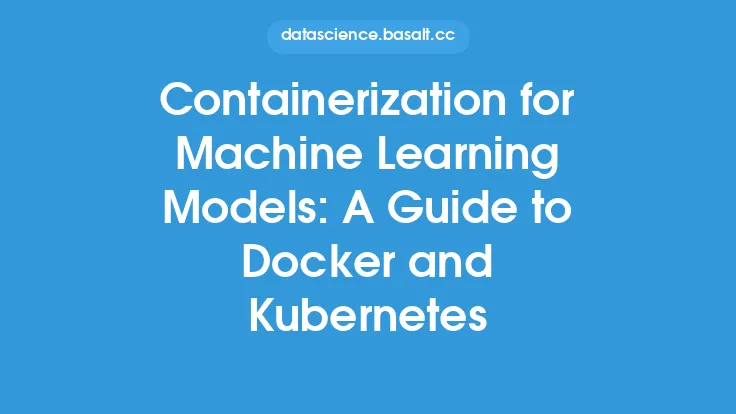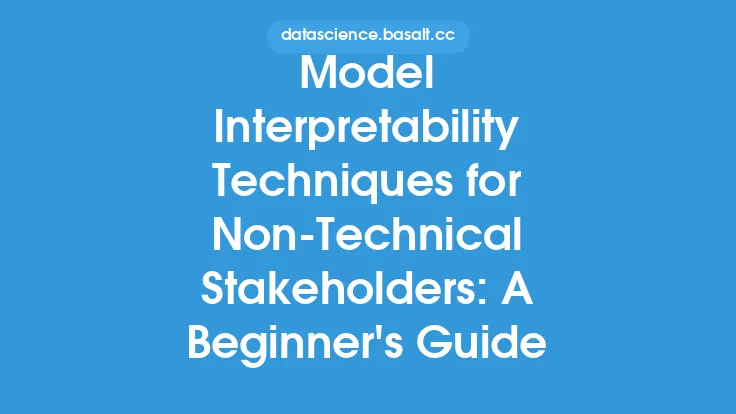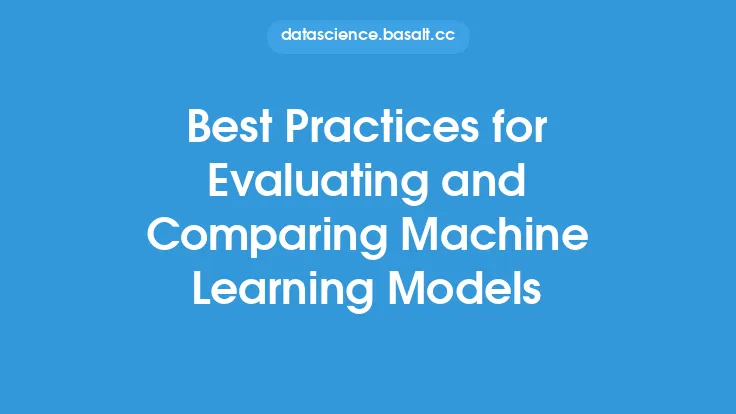Machine learning models have become increasingly complex and powerful, allowing them to make accurate predictions and drive business decisions. However, this complexity comes at a cost, making it challenging to understand how these models arrive at their predictions. Model interpretability techniques aim to address this issue by providing insights into the decision-making process of machine learning models. In this article, we will delve into the various techniques used for interpreting machine learning models, exploring their strengths, weaknesses, and applications.
Introduction to Model Interpretability Techniques
Model interpretability techniques can be broadly categorized into two types: model-specific and model-agnostic. Model-specific techniques are designed for specific machine learning algorithms, such as decision trees or neural networks, and provide detailed insights into the model's internal workings. Model-agnostic techniques, on the other hand, can be applied to any machine learning model, regardless of its type or complexity, and provide more general insights into the model's behavior. Some common model-agnostic techniques include feature importance, partial dependence plots, and SHAP (SHapley Additive exPlanations) values.
Feature Importance Techniques
Feature importance techniques aim to identify the most relevant features contributing to a model's predictions. These techniques can be further divided into two subcategories: permutation feature importance and recursive feature elimination. Permutation feature importance involves randomly permuting the values of a feature and measuring the decrease in model performance. Recursive feature elimination, on the other hand, involves recursively removing the least important features and measuring the decrease in model performance. Feature importance techniques are useful for identifying the most relevant features in a dataset and can be used to select the most informative features for model training.
Partial Dependence Plots
Partial dependence plots are a type of model interpretability technique that provides insights into the relationship between a specific feature and the predicted outcome. These plots show the average predicted outcome for a given feature value, while holding all other features constant. Partial dependence plots are useful for understanding how a specific feature affects the model's predictions and can be used to identify non-linear relationships between features and outcomes. However, these plots can be misleading if the feature of interest is highly correlated with other features, as the plot may not accurately reflect the true relationship between the feature and outcome.
SHAP Values
SHAP values are a type of model interpretability technique that assigns a value to each feature for a specific prediction, indicating its contribution to the outcome. SHAP values are calculated based on the concept of Shapley values, which is a method for assigning a value to each player in a cooperative game, based on their contribution to the game's outcome. SHAP values are useful for understanding how each feature contributes to a specific prediction and can be used to identify the most important features driving a model's predictions. However, SHAP values can be computationally expensive to calculate, especially for large datasets.
Model-Specific Interpretability Techniques
Model-specific interpretability techniques are designed for specific machine learning algorithms and provide detailed insights into the model's internal workings. For example, decision trees can be interpreted by analyzing the tree structure and identifying the most important features and split points. Neural networks, on the other hand, can be interpreted using techniques such as saliency maps, which highlight the most important input features driving a model's predictions. Model-specific techniques are useful for understanding the intricacies of a specific model and can be used to identify areas for improvement.
Model Interpretability for Ensemble Models
Ensemble models, such as random forests and gradient boosting machines, are challenging to interpret due to their complexity. However, several techniques can be used to interpret ensemble models, including feature importance, partial dependence plots, and SHAP values. Additionally, techniques such as tree SHAP and tree explainer can be used to interpret the decision-making process of individual trees in an ensemble model. Model interpretability for ensemble models is crucial, as these models are widely used in practice and can be difficult to understand without proper interpretation techniques.
Model Interpretability for Deep Learning Models
Deep learning models, such as neural networks and convolutional neural networks, are challenging to interpret due to their complexity and non-linear nature. However, several techniques can be used to interpret deep learning models, including saliency maps, feature importance, and SHAP values. Additionally, techniques such as layer-wise relevance propagation and deepLIFT can be used to interpret the decision-making process of individual layers in a deep learning model. Model interpretability for deep learning models is crucial, as these models are widely used in practice and can be difficult to understand without proper interpretation techniques.
Best Practices for Implementing Model Interpretability
Implementing model interpretability techniques requires careful consideration of several factors, including model complexity, data quality, and computational resources. Some best practices for implementing model interpretability include selecting the most appropriate technique for the specific model and problem, using visualization tools to communicate results, and considering the limitations and potential biases of each technique. Additionally, it is essential to consider the needs and goals of stakeholders, including non-technical stakeholders, and to provide clear and concise explanations of the results.
Future Directions for Model Interpretability
Model interpretability is a rapidly evolving field, with new techniques and methods being developed continuously. Some future directions for model interpretability include the development of more efficient and scalable techniques, the integration of model interpretability with other machine learning tasks, such as model selection and hyperparameter tuning, and the application of model interpretability to new domains, such as natural language processing and computer vision. Additionally, there is a growing need for more transparent and explainable models, which can be achieved through the development of new model interpretability techniques and the integration of interpretability into the model development process.
Conclusion
Model interpretability techniques are essential for understanding the decision-making process of machine learning models. By providing insights into the model's internal workings, these techniques can be used to identify areas for improvement, select the most informative features, and communicate results to stakeholders. In this article, we have explored various model interpretability techniques, including feature importance, partial dependence plots, SHAP values, and model-specific techniques. We have also discussed the challenges and limitations of implementing model interpretability techniques and provided best practices for selecting and applying these techniques. As machine learning continues to evolve and play a larger role in our lives, the importance of model interpretability will only continue to grow, and it is essential to stay up-to-date with the latest developments and techniques in this field.





